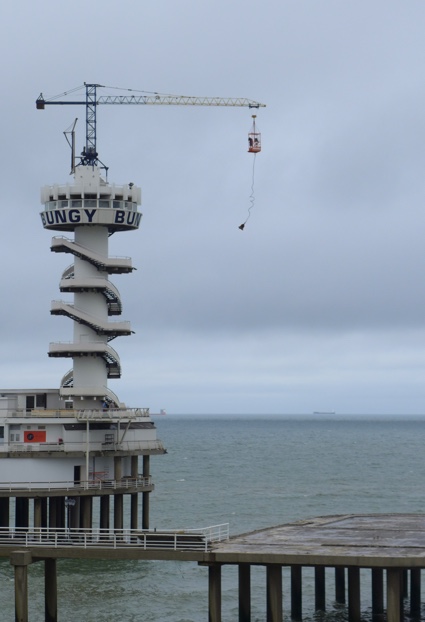 Mike Rijnierse, KLOK, 2015
Mike Rijnierse, KLOK, 2015
I only went once to the festival TodaysArt in The Netherlands. It was a long time ago, i was in The Hague for a totally unrelated conference and decided to spend the evening walking around the city. Everywhere i looked there were projections on buildings, performances in shop windows and sound pieces. The one installation that blew me away turned a long shopping street into an airport landing strip. The author of the work, Mike Rijnierse, was using controllable lights and loud speakers to recreate the experience of airplanes landing in the middle of the shopping area.
Rijnierse has since become a regular of TodaysArt. He even once used the whole train station -building, travelers, trams and trains- for a sound performance. For this year’s edition of the festival, the artist has decided to submit a 100 kg church bell to regular sessions of bungee jumping. The sounding bell will drop from a bungee jump tower at the Scheveningse Pier near The Hague and its sixty meter fall will cause a Doppler effect, a change in frequency and wavelength for an observer moving relative to its source. The classical example of the phenomenon is the siren of the ambulance or police car. You hear the high pitch of the siren of the vehicle as it is approaching but its pitch seems to suddenly drops as it passes you. Similarly, the sound experience of the falling bell will vary as the object approaches, passes, and recedes from the audience.
I won’t be able to make it to the festival this year (alas!), but i was so curious to know more about KLOK and Mike Rijnierse‘s practice that i contacted him for a quick online interview:
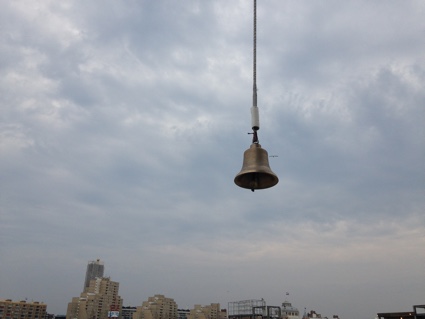 Mike Rijnierse, KLOK, 2015
Mike Rijnierse, KLOK, 2015
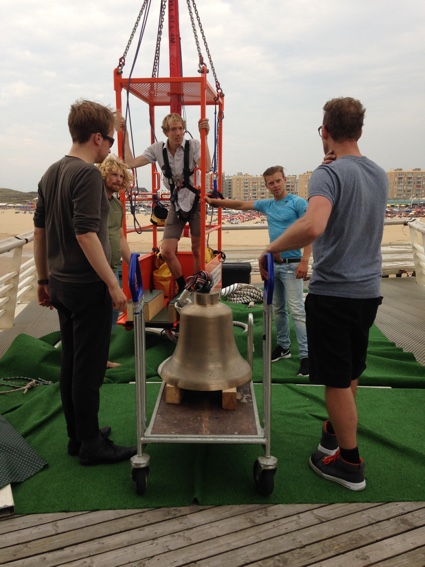 Mike Rijnierse, KLOK, 2015
Mike Rijnierse, KLOK, 2015
Hi Mike! During the TodaysArt festival, you will be throwing a 100 kg church bell from the bungee jump. That sounds tricky. Does a 100 kg bell behave exactly like a 100 kg human body when thrown from above?
A 100 kg of bronze behaves very different than a living body. The good thing is that the bell is made to do only one thing and that is to sound, so I don’t need to explain the bell what to do.
Are there special precautions you need to observe in order to ensure that the performance goes as planned?
Apart from some practical issues, for example how to transport the bell safely or how to prepare the bell for the fall, I needed quite some luck too. I had to communicate with a lot of people in order to realize this project, so that all parties I depended on would support the project. And so far I’ve been very lucky.
The project started by reading in a local newspaper that the Bungy Scheveningen wanted to return to the pier after having been closed down. Knowing that TodaysArt was planning to use the pier as their venue for the 2015 edition, the news about the Bungy Scheveningen immediately triggered my focus. I guess the plan of dropping a church bell from the bungee tower was already constructed in my subconscious and came to the surface in a split second, like a puzzle that falls together. When I started proposing the concept to the organisation of TodaysArt, they first told me to be patient before starting the production.
After a week I couldn’t wait anymore and I started calling the Royal Eijsbouts Bell Foundry, the world’s largest manufacturer of cast bronze bells, carillons, swinging bells and clock towers. While contacting them for asking whether they wanted to contribute to the project, and explaining it to Joep van Brussel (project manager of the Royal Eijsbouts), he asked if he had understood it correctly: “So, it is like cycling towards a church with the speed of 60 km per hour?”. The answer lies in the question. Joep immediately understood what was the concept of KLOK.After one meeting with Mirte Koeleman (manager of Bungy Scheveningen), I had a project. I was just damn lucky that everyone was 100% supportive.
As for the performance itself, I had to study the ways the bell would fall from the tower and make the best of it in order to create the sound experience, namely the doppler effect. Together with the crew of Bungy Scheveningen we’ve tested different qualities of elastics and different ways of releasing the bell in the air. Everything worked surprisingly smoothly and that made me a lot more confident.
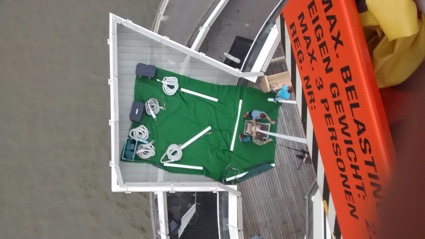 Mike Rijnierse, KLOK, 2015
Mike Rijnierse, KLOK, 2015
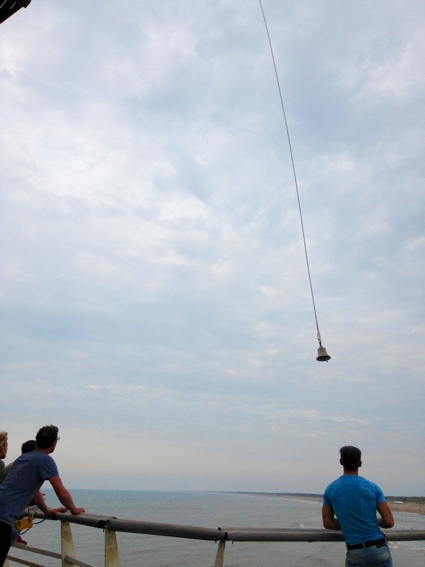 Mike Rijnierse, KLOK, 2015
Mike Rijnierse, KLOK, 2015
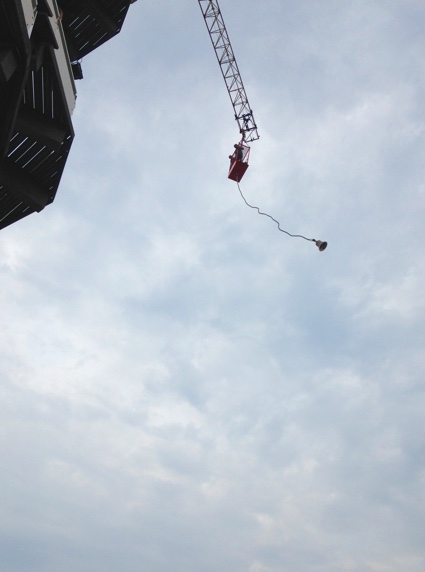 Mike Rijnierse, KLOK, 2015
Mike Rijnierse, KLOK, 2015
Is the bell modified in any way to create a particular sound? Or will you be working with a ‘normal’ cast bronze bell?
Together with Joep van Brussel (from the bell foundry Royal Eijsbouts) I considered modifying the construction of the clapper. But after the tests we’ve decided to leave the bell as it is.
I read you want to create a doppler effect. Could you tell us more about the sound experience? Is there an optimal position where the audience will have to stand in order to fully enjoy the performance, for example?
The doppler effect is not something I want to create but to experience. It is a physical phenomenon that occurs between a sound object and the observer, while either one of them is in motion. The location of ‘Bungy Scheveningen’ is quite unique. They’re located in the tower of the pier. The length of the fall is 60 meters above the surface of the North Sea. The water level varies a lot because of the tides. That will probably make a difference in experiencing KLOK from the beach. We’ve already tested the installation and I experienced it from the tower. From this position you will be the closest to the bell. Now I’m curious to observe the installation from different places!
I’m also curious about the duration of KLOK. Is this going to be just a one off? that will last just a few seconds?
We are planning to drop the bell every hour, so that the public has the opportunity to hear the installation from different angles. So every hour you’ll have a unique 20 second composition.
Mike Rijnierse, THX: INT’L (landing strip) at Todaysart, 2007
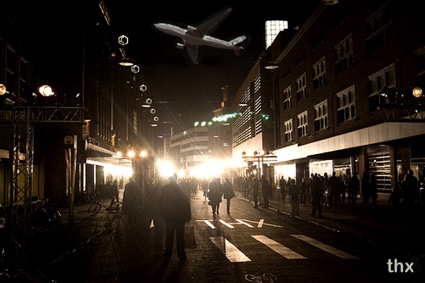 Mike Rijnierse, THX: INT’L (landing strip) at Todaysart, 2007
Mike Rijnierse, THX: INT’L (landing strip) at Todaysart, 2007
I’m very impressed by the way you ‘use’ a city as a vast playground and field for sound experiments. That is the case with other works such as Station to Station, THX_The Hague INT’L (where you had to close down the street lights as I heard in the video of your talk at Sonica!), etc. Are there other ambitious sound projects you would dream of making in urban spaces but never got the necessary authorisation/money/time to do so far?
It is fascinating what happens in the process of executing these projects. The first time I played with a multi loudspeaker setting in the central street of The Hague in 2005, I was playing with this setup from 12:00 AM till 12:00 PM for two days in a row. After the performance I wrapped my equipment and went to a bar at the main square for some drinks. What I noticed then was that my audition had adapted to long distance reflections of the city, I could hear the sounds hitting the different surfaces of the buildings and at the same time I was not able to engage in short range, ordinary conversations. It was as if my brain had learned from those sonic experiences after a few days of work and I couldn’t follow what people were saying very close to me any more.
A project I am working at the moment derived from this echolocation experience. It is a large relief that offers a range of sound reflections produced by a single source. So I want to give my echolocation experience back to the audience. Maybe RELIEF will result in another project. I have some other plans and ideas for playing with sound reflection. So… Yes!
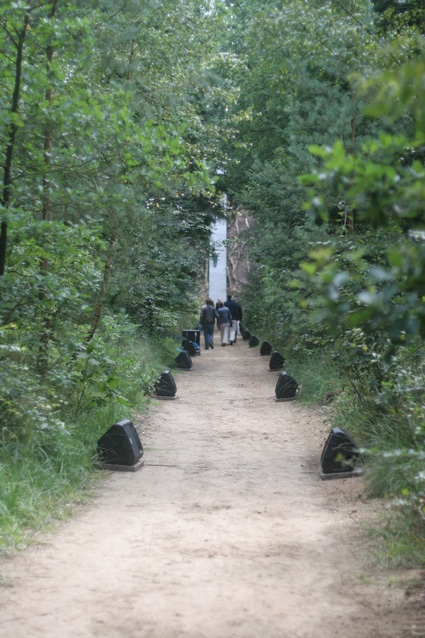 Mike Rijnierse, PAN, 2005
Mike Rijnierse, PAN, 2005
Still in that same video of your talk at Sonica, you explain that recording the sound of an airplane was too tricky so you ended up recording the sound of your hoover. That reminded me the sound effects used in cinema. Are there other particular ‘tricks’ and ‘cheats’ you’ve used to convey a particular sound or experience in any of your other projects?
Sure, in fact it is theater. The THX_The Hague INT’ L derives from the installation PAN which I made for the Kröller Müller Museum, in August 2005 in collaboration with Detlef Tividor Villerius. In the sculpture garden of the museum we amplified a corridor with loudspeakers identical to the landing strip. I used all kinds of recordings such as the sound of frying potatoes. By processing those sounds I turned them into a ‘pandemoniac’ soundscape along the 16 channel speaker corridor through the forest. During TodaysArt 2005 I performed this piece in a slightly different setting, in the same street where THX_The Hague INT’L took place in 2007.
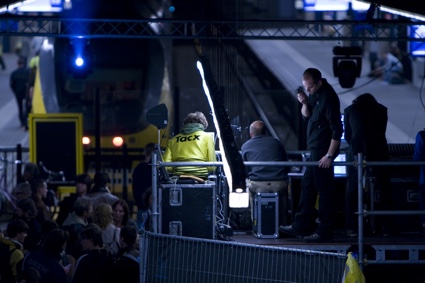 STATION TO STATION, TodaysArt 2008
STATION TO STATION, TodaysArt 2008
Mike Rijnierse with Staalplaat Soundsystem, Erik Hobijn and Jens Alexander Ewald, Station to Station, 2008
What were the biggest challenges you encountered with Station to Station? Because it looks so sophisticated logistically. How did you manage to choreograph something so complex?
Again I was lucky to count on so many people and other artists willing to make that happen. I came with the plan of using the train tracks as soundtracks to be recorded in real time and generate a live composition. The Hague central station is an end station. From top view it has many similarities with a sound mixer. Somehow this analogy convinced all parties. We started researching the trains themselves and found out that we could use the overpressure of the compressors. We managed to use the typhoons of the trains. And for each track we had a person catching sounds with a wireless microphone. This instrumentation in combination with the regular timetable of the trains became our score.
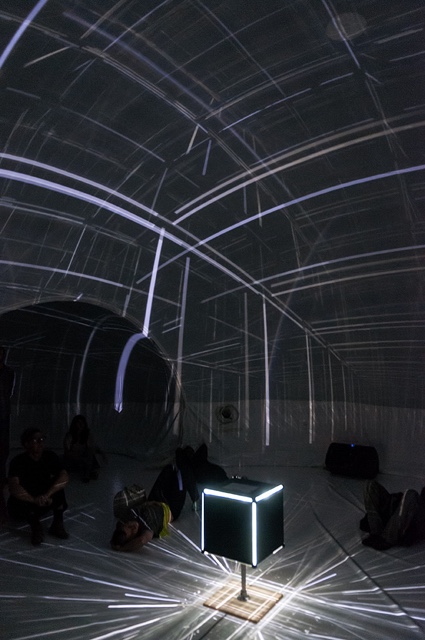 CUBE in Cocky Eek’s Sphæræ. Photo : Ed Jansen
CUBE in Cocky Eek’s Sphæræ. Photo : Ed Jansen
What is next for you? Any upcoming performance, work or event you could share with us?
During TodaysArt 2015 on september 25 and 26 I will present two works: KLOK and Countdown. At the moment I am also performing in the music theater play Peloton with Rosa Ensemble. And my new light installation CUBE will be exhibited in some places in the Netherlands soon. With Rosa Ensemble we are preparing a new piece called AKASHA which will premiere in spring 2016.
Thanks Mike!
Check out KLOK at the TodaysArt festival on 25 + 26 September on the Scheveningse Pier near The Hague, NL.
TodaysArt is part of SHAPE, a platform for innovative music and audiovisual art from Europe.
